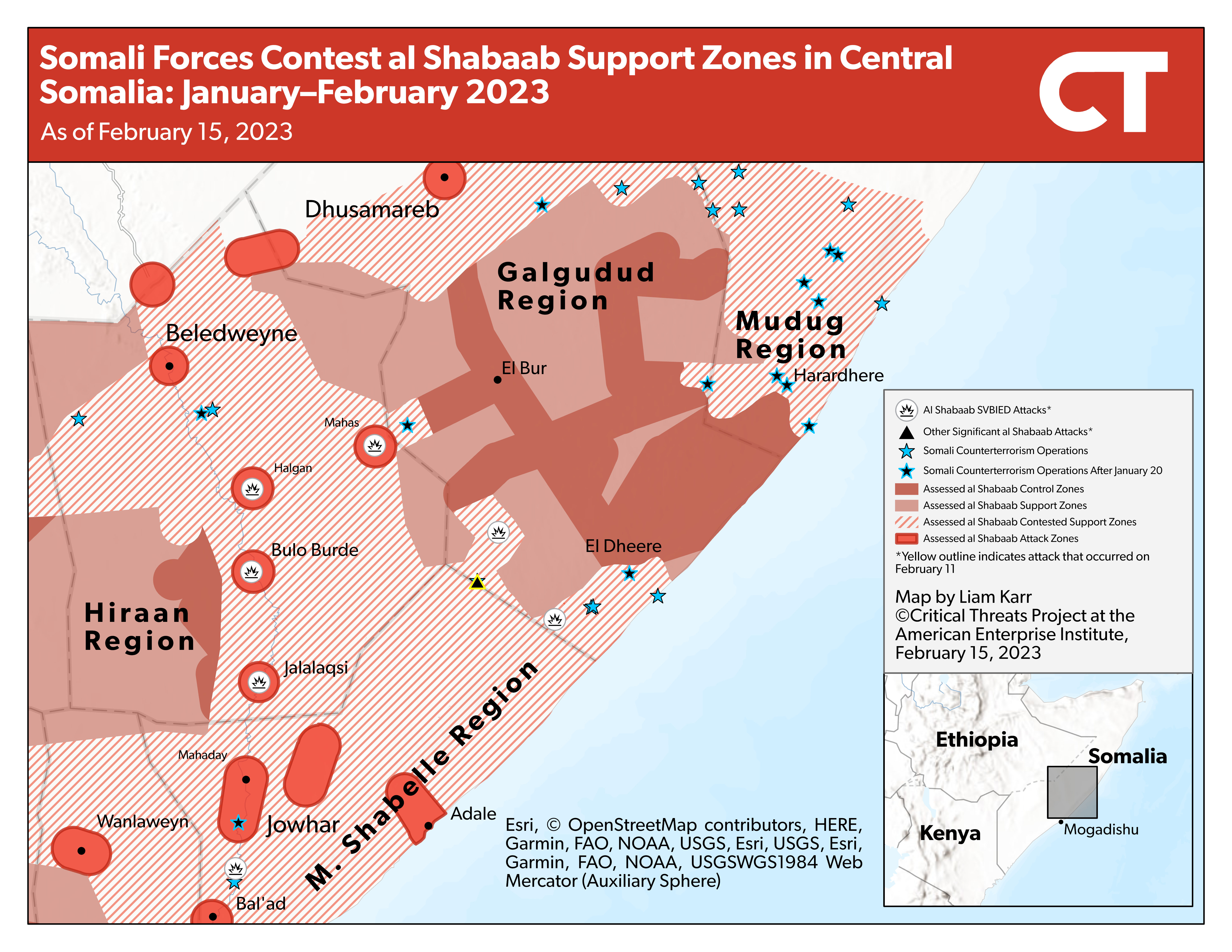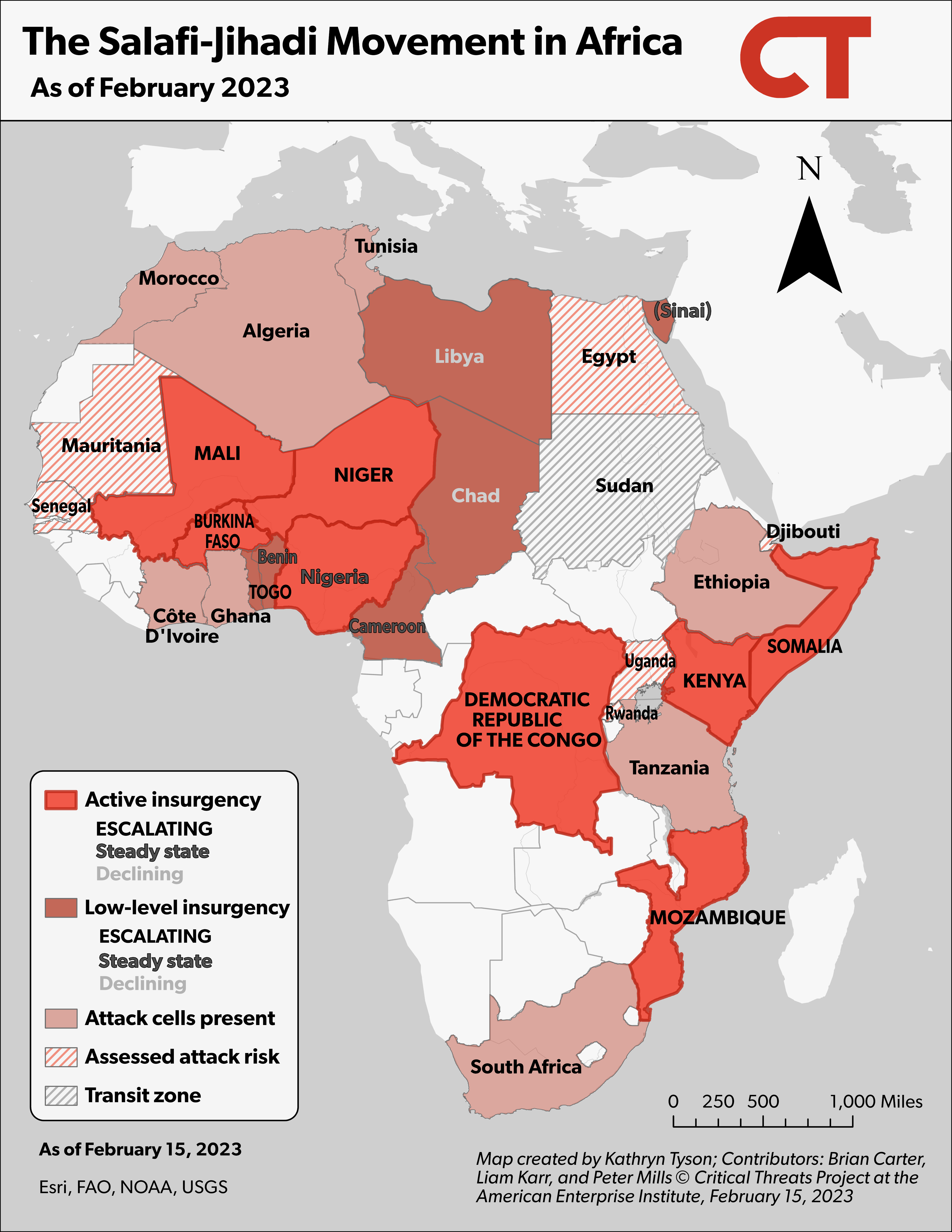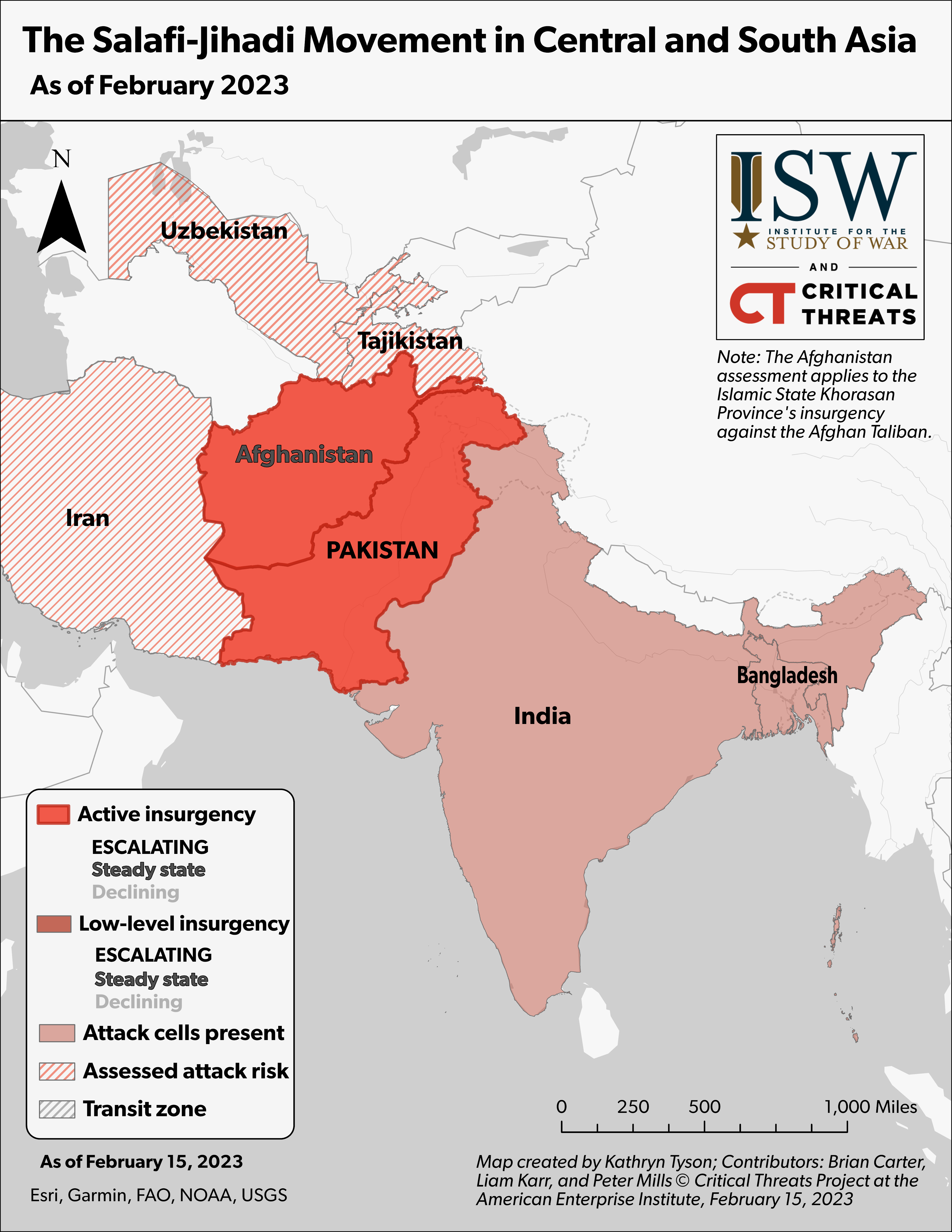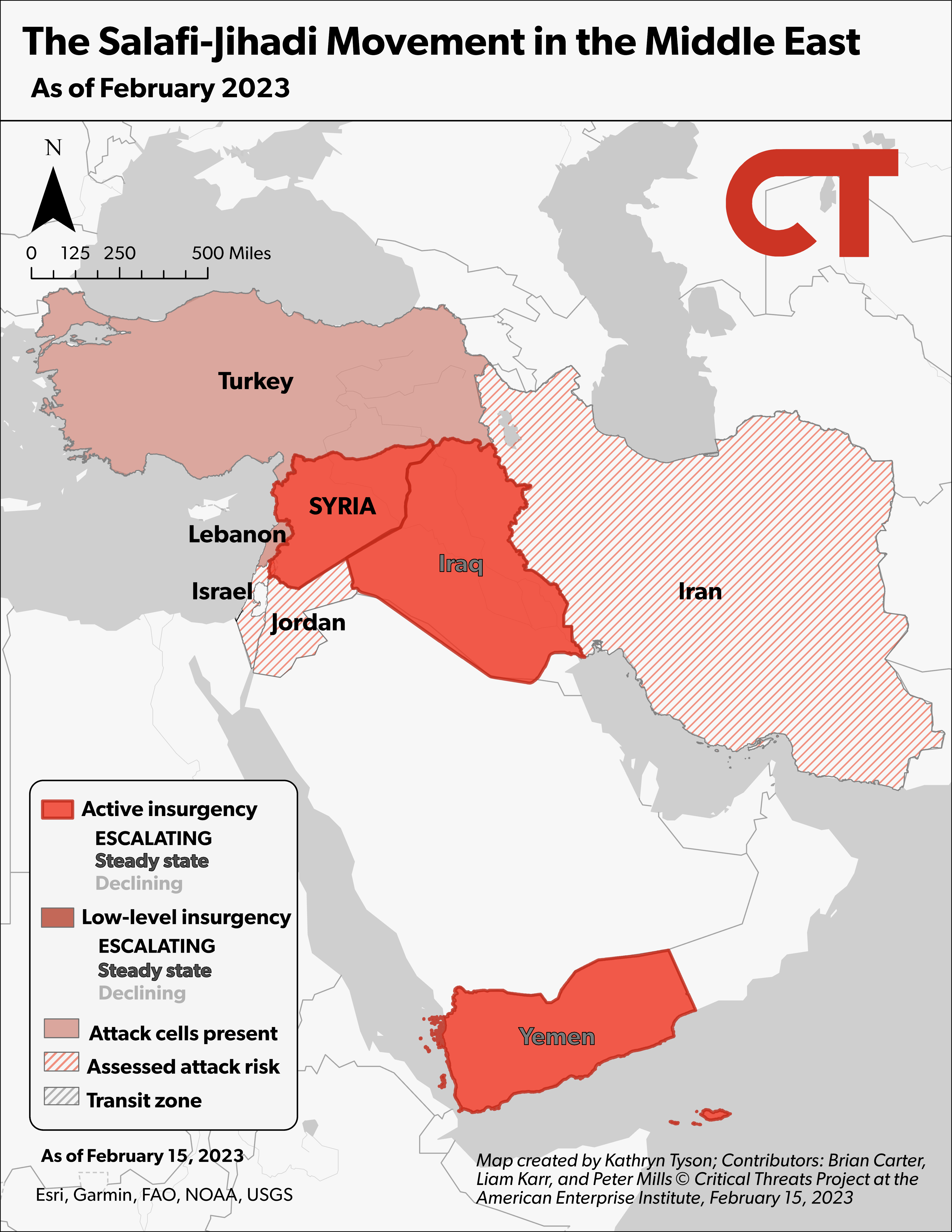 |
 |
Salafi-Jihadi Movement Weekly Update, February 15, 2023

Authors: Liam Karr, Peter Mills, Brian Carter, Kathryn Tyson
Contributor: Will Harvey
To receive the Salafi-Jihadi Movement Weekly Update via email, please subscribe here. Follow CTP on Twitter, LinkedIn, and Facebook.
Data Cutoff: February 15, 2023, at 10 a.m.
Key Takeaways:
Somalia. Several large-scale al Shabaab attacks on military bases across Somalia highlight that Somali counterterrorism efforts have not weakened the group’s attack capabilities. Meanwhile, al Shabaab is also well positioned to take advantage of a festering clan-based conflict in northern Somalia’s disputed regions. A prolonged battle would reduce counterterrorism pressure on al Shabaab and Islamic State havens in northern Somalia.
Mali. The Malian junta appointed several pro-Russian figures to high-ranking military positions, indicating growing Russian influence over the Malian government. The junta could be planning to leverage Russian assistance in a northern Mali offensive in a highly unlikely but dangerous scenario. Any such offensive would likely increase links between militia groups and al Qaeda’s Sahelian branch without having long-term success.
Afghanistan. Taliban Minister of Interior and Haqqani Network leader Sirajuddin Haqqani issued a rare public criticism of the Taliban leadership, indicating escalating tensions in the Taliban government. Tension in the Taliban movement will continue to build but is unlikely to result in an intra-Taliban civil war in the short run. However, the Taliban supreme leader’s unwillingness to compromise will alienate important Taliban leaders and raise the risk of fracturing the Taliban movement over time.
Assessments:
Somalia. Recent Somali government operations have failed to weaken al Shabaab’s attack capabilities. Al Shabaab carried out several large-scale attacks across three regions in Somalia on February 11.[1] The scale and breadth of the attacks highlight that al Shabaab retains significant capabilities throughout Somalia despite facing increased military pressure. Two of the three attacks on February 11 were complex operations that combined suicide vehicle-borne improvised explosive devices (SVBIED) and ground forces.[2] The attacks, which were spread across 375 miles, indicate the group can coordinate major attacks in several areas simultaneously, despite military pressure. The group has also demonstrated it maintains deadly and sophisticated capabilities through its January SVBIED wave in central Somalia and its suicide siege campaign in Mogadishu that has been ongoing since September 2022.[3]
Al Shabaab is likely trying to stall the ongoing Somali government counterterrorism offensive by targeting bases that have been important staging points for the offensive. One of the February 11 attacks struck a base on the border of the Galgudud and Middle Shabelle regions. Somali forces reportedly regrouped at the base in late January after al Shabaab overran their forward base in the Galgudud region on January 20.[4] Al Shabaab also attacked a base in the Lower Jubba region on February 11 that Somali officials had branded as the hub for a southern Somalia offensive the day before.[5]
Figure 1. Al Shabaab–Related Activity in the Lower Jubba Region: January–February 2023
Source: Liam Karr.
These attacks could delay or prevent counterterrorism efforts by weakening the capacity of Somali forces and denying Somali forces launching pads for their operations. Somali officials claimed government forces repelled two of the attacks and have not acknowledged the third in Middle Shabelle. However, al Shabaab released photos of the attack in Middle Shabelle that showed it overran the base and inflicted severe casualties.[6] Somali forces in central Somalia have not yet retaken the initiative along Galgudud’s western border, where al Shabaab inflicted heavy casualties during its SVBIED wave in January.[7] A similar pattern could play out in southern Somalia if al Shabaab sustains pressure on Somali bases.
Figure 2. Somali Forces Contest al Shabaab Support Zones in Central Somalia: January–February 2023
Source: Liam Karr.
Northern Somalia Disputed Territories. Ongoing unrest in the disputed regions of northern Somalia could increase the Salafi-jihadi threat there by relieving counterterrorism pressure on al Shabaab and Islamic State militants and presenting these groups a recruitment opportunity. Somaliland security forces and militia from the Dhulbahante clan—a minority clan in Somaliland-administered territory that have a significant presence in the disputed regions and share clan ties with the majority clan in the semiautonomous Puntland State in northern Somalia[8]—have been fighting in the town of Las’anod since February 6.[9] Las’anod is the capital of the Sool region, one of three disputed regions contested by the de facto independent state of Somaliland and the Puntland State. The clashes began after weeks of unrest and likely security force abuses following the assassination of a local opposition politician on December 26.[10] The incident reignited decades-old tensions between the Dhulbahante and Somaliland over long-standing Dhulbahante demands for self-determination.[11] The February fighting has reportedly involved indiscriminate shelling and killed at least 57 people.[12]
A prolonged crisis will reduce counterterrorism pressure on Salafi-jihadi havens in northern Somalia. Al Shabaab and the Islamic State’s Somalia branch are both active in Puntland State and the disputed regions. Both groups use northern Somalia primarily as a smuggling and funding node but also carry out occasional attacks against Somali security forces and each other.[13] Al Shabaab is the stronger of the two and is capable of seizing villages.[14] The Las’anod clashes have increased the likelihood of a potential showdown between Puntland and Somaliland, given the clan-based nature of the Las’anod conflict and Puntland’s shared clan ties with the Dhulbahante that serve as the basis for Puntland’s claim to the disputed territories.[15] Fighting between Somaliland and Puntland forces would distract security forces—including US-trained special forces—from counterterrorism operations, relieving pressure on the Salafi-jihadi groups and their global financing networks.[16]
Al Shabaab could also send fighters to inflame the conflict or, in a worst-case scenario, co-opt the rebelling fighters. Al Shabaab has historically integrated into communities across Somalia by capitalizing on disenfranchised and marginalized minority clans.[17] The long-standing Dhulbahante grievances against the Somaliland administration and more recent claims of security force abuses make clan militia in Las’anod ripe for al Shabaab exploitation.[18] These demographic factors also intersect with the fact that most of the remaining fighters in Las’anod are young men, who are more vulnerable to Salafi-jihadi messaging.[19] There is no independent consensus on whether there is an active or official al Shabaab presence in Las’anod. The Somaliland government has claimed al Shabaab is already working with the rebelling clan militia, which al Shabaab has denied.[20] Prominent analysts are divided on the issue.[21]
Mali. The Malian junta appointed several pro-Russian figures to high-ranking military positions, indicating growing Russian influence over the Malian government. Junta leader Assimi Goita replaced several of Mali’s top military leaders with pro-Russian figures in a mini purge on January 8. Goita notably appointed the Malian ambassador to Russia as chief of staff of the army and replaced Mali’s chief of staff of the national guard, who had significant French ties.[22]
The appointments and their timing indicate that Mali will likely expand its partnerships with Russia and the Kremlin-linked Wagner Group. The move came a day after Russian Foreign Minister Sergei Lavrov’s first visit to Mali, where he reportedly met with Goita and made undisclosed security agreements.[23] Russian-linked outlets in Mali also began an information operation calling for more Wagner bases days before the reshuffle.[24] Alternatively, Goita may have been trying to prevent a coup, though there is no evidence that any of the targeted commanders were involved in a plot.[25] Greater Wagner Group involvement will spread the group’s pattern of human rights abuses and resentment that benefit Salafi-jihadi groups.[26]
The Malian junta could be planning to use increased Russian assistance in a northern Mali offensive. A member of the transitional government recently alleged the junta was preparing to retake northern Mali, where the government has been largely absent for over a decade.[27] The Malian government’s longtime inability to hold northern Mali would make Russian support crucial to any serious effort to assert itself in the area.[28] A mix of former pro-separatist rebels and pro-government militias are the de facto governing powers in the region.[29] The pro-separatist groups formally unified in February, after effectively withdrawing from the 2015 peace agreement with the Malian government in December, indicating they could be preparing to declare formal independence.[30] Al Qaeda’s Sahelian branch, Jama’at Nusrat al Islam wa al Muslimeen (JNIM), is currently expanding its control over the region by working with these same former rebel groups and the pro-government militias as part of an anti–Islamic State coalition.[31] See CTP’s latest Africa File, “Al Qaeda–Linked Militants Take Control in Northern Mali,” for a complete analysis on how JNIM is filling the security vacuum in northern Mali to gain de facto control of the region.[32]
However, a northern campaign is highly unlikely. The government official’s claim is isolated and unsupported. The Malian junta also has more pressing security concerns, with an ongoing JNIM offensive in more politically sensitive areas of southern Mali.[33] It is also unlikely the Russian government would support such an offensive given its continued insistence on upholding the 2015 peace agreement.[34] A government offensive would unlikely be more successful than previous failed government efforts to assert control over northern Mali, and it would lead the myriad of armed groups in the area to tighten their relationship with JNIM.[35]
Figure 3. The Salafi-Jihadi Movement in Africa
Source: Kathryn Tyson.
Afghanistan. A rare display of public criticism between Taliban leaders indicates internal regime disagreements are beginning to boil over into the open. Taliban Interior Minister and Haqqani Network leader Sirajuddin Haqqani gave a speech on February 11 to his supporters in Khost Province that criticized the Taliban leadership for its governance failures and monopolization of power, framing the current situation as “intolerable.”[36] Haqqani’s speech implicitly called out the increasing concentration of power around Supreme Leader Haibatullah Akhundzada and his supporters. He also implied Taliban leaders had failed to address the Afghan people’s problems and violated their rights.[37] Haqqani’s comments likely referred to Akhundzada’s policies that banned education for girls, as he has repeatedly and publicly expressed support for Afghan girls returning to school. Haqqani likely voices these views with the intent to secure greater international engagement and the resumption of foreign development financial aid to Afghanistan.[38]
Several Taliban leaders from across the Taliban movement have offered implicit support for Haqqani’s critiques. Taliban Deputy Prime Minister Abdul Salam Hanafi gave a speech on February 13 that implicitly supported Haqqani’s speech and included thinly veiled criticisms of Akhundzada’s unpopular ban on girls’ education.[39] Taliban Minister of Defense Mohammad Yaqoub warned the Taliban leadership against becoming “arrogant” and implored them to listen to the “legitimate demands of the nation” in a speech echoing Haqqani’s critiques on February 15.[40] Yaqoub gave this speech alongside additional senior Taliban and Haqqani Network leaders, indicating these concerns are shared across Taliban factions.[41]
The Taliban spokesman Zabihullah Mujahid tried to act as a mediator by both condemning Haqqani’s public criticism and implying that he should not be punished.[42] Disputes between Taliban leaders are usually kept private, and it is rare for Taliban leaders to publicly criticize each other. Akhundzada’s continued refusal to contemplate altering hard-line policies or rule in a less autocratic manner is forcing these disagreements into the open.[43] Some sources report the Taliban cabinet want Akhundzada to step down if he does not reconsider his ban on girls’ education.[44] Akhundzada is a highly ideological individual who is extremely unlikely to willingly cede his position as supreme leader of the Taliban movement.[45]
The response from Akhundzada’s faction to Haqqani’s speech indicates it will neither compromise nor change policy. Akhundzada’s faction continues to emphasize the religious duty to obey the Taliban supreme leader regardless of whatever personal misgivings a Taliban leader may have about his policies. The Taliban governor of Kandahar stated every Taliban leader is religiously obliged to follow Akhundzada due to a pledge of allegiance, an implicit critique of Haqqani.[46] The Kandahar governor is close to Akhundzada, who is based in Kandahar.[47]
Disagreements between Taliban leaders will likely escalate unless the Taliban supreme leader compromises on hard-line social policies and returning some power to the Taliban cabinet in Kabul, despite some Taliban leaders’ efforts to mediate the dispute. The Taliban supreme leader is likely preparing to use coercion to force through more unpopular policies in the face of increasing opposition. Afghan journalists reported that Akhundzada is seeking to build a 35,000-strong military unit that would be solely loyal to him and unaffiliated with any other Taliban faction.[48] Akhundzada recently convened a conference in Kandahar to discuss implementing a ban on opium cultivation.[49] A ban on opium cultivation would negatively affect important sources of revenue for many Taliban leaders. Akhundzada may also be moving to curtail Taliban commanders’ freedom of action by clamping down on extrajudicial killings.[50] Akhundzada could use his own military forces to coerce Taliban commanders and leaders into following these additional unpopular policies.
These disputes will continue to build tensions in the Taliban movement, but open civil war between the Taliban factions is unlikely in the short run. The Taliban leadership knows that an open civil war between Taliban factions would destroy the nascent Taliban state and imperil their ability to control Afghanistan. This is likely one of the most important factors keeping the Taliban government together, despite escalating internal disagreements. The Taliban factions opposed to the supreme leader are unlikely to openly fight his faction until tensions reach the point at which they believe the continuation of the supreme leader’s policies pose more of a threat to the survival of the Taliban government than the risk of moving to depose him.
Figure 4. The Salafi-Jihadi Movement in Central and South Asia
Source: Kathryn Tyson.
Middle East. There have been no significant updates from this region in the past week.
Figure 5. The Salafi-Jihadi Movement in the Middle East
Source: Kathryn Tyson.
Other Updates:
Middle East
Iraq. Operation Inherent Resolve’s (OIR) support to the Iraqi Security Forces remains important to the defeat ISIS, though the effectiveness of ISF units is increasing. The Iraqi army and air force are contributing to the degradation of ISIS by eliminating mid-level leaders with OIR support. The Iraqi air force killed the ISIS Wali in Diyala in an airstrike near Hamrin Dam, Diyala province, on February 12.[51] The OIR inspector general report for quarter four in 2022 noted that OIR enables “nearly all” Iraqi air force air strikes, though Iraqi F-16s laser designate their own targets in some less “difficult” situations.[52]
Yemen. Infighting and mutinies in Yemeni military units will provide opportunities for al Qaeda in the Arabian Peninsula (AQAP) to increase its influence in southern and eastern Yemen. A special forces unit in southern Yemen mutinied after the Yemeni Interior Ministry removed the unit’s chief of staff on February 10.[53] This is the second mutiny since December, when units from the 1st Military Region refused to allow the new 1st Military Region chief of staff to assume his post.[54] See CTP’s February 8, 2023 Salafi-Jihadi Movement Weekly Update for a complete analysis of the Yemeni government’s recent security reshuffling and its effect on AQAP. Yemeni military units also mutinied in 2012 and 2013, after former President Abdu Rabbu Mansour Hadi assumed the presidency and ordered command changes.[55] AQAP benefited from these mutinies, entrenching itself and increasing its influence during a period of government infighting.
South Asia
Al Qaeda may have launched a media campaign to denounce the burning of a Quran in Sweden on January 21.[56] Al Qaeda in the Indian Subcontinent (AQIS) condemned the Quran burning on February 9 and incited supporters to attack in retaliation, but it did not specify a particular target.[57] AQIS has limited capabilities and has not attacked since 2016.[58] Al Qaeda’s central media outlet also condemned the incident on February 10.[59] Other al Qaeda affiliates may participate in the media campaign. Al Qaeda affiliates in Yemen and Somalia previously participated in a media campaign against an Indian politician’s controversial remarks about the Prophet Muhammad in July 2022.[60]
Pakistan. The Islamic State Khorasan Province (ISKP) may be expanding attacks to diplomatic missions in Pakistan. A UN office in Pakistan warned of a possible ISKP attack on diplomatic targets in Islamabad and Rawalpindi in northern Pakistan on February 9. The UN said the attack would likely be in retaliation for the burning of a Quran in Sweden on January 21. ISKP previously carried out a high-profile assassination attempt on the Pakistani ambassador to Afghanistan on December 2022, but it has not targeted diplomats in Pakistan.[61] The Islamic State Pakistan Province (ISPP), which has close ties to ISKP, may alternatively have been responsible for the threat. ISKP did not carry out attacks in Islamabad or Rawalpindi in 2022, but ISPP carried out several minor attacks in these areas in 2022.[62]
[1] https://www.criticalthreats.org/briefs/gulf-of-aden-security-review/gulf...
[2] SITE Intelligence Group, “Shabaab Claims 110+ Casualties in Suicide Bombings, Major Offensives on Multiple Bases in Southern Somalia,” February 11, 2023, available by subscription at www.siteintelgroup.com
[3] https://www.criticalthreats.org/analysis/salafi-jihadi-movement-weekly-u...
[4] https://www.criticalthreats.org/briefs/gulf-of-aden-security-review/gulf... https://www.caasimada dot net/xog-ciidamada-dowladda-oo-isaga-soo-baxay-degmada-galcad
[5] https://radiorisaala dot com/jubbaland-oo-ku-dhawaaqday-wajiga-labaad-ee-howlgalka-ka-dhanka-ah-al-shabaab
[6] SITE Intelligence Group, “Shabaab Claims 110+ Casualties in Suicide Bombings, Major Offensives on Multiple Bases in Southern Somalia”; SITE Intelligence Group, “Shabaab Documents Aftermath of Major Offensive in Middle Shabelle, Boasts Success in Guerrilla Warfare Tactics,” February 14, 2023, available by subscription at www.siteintelgroup.com; https://www.criticalthreats.org/briefs/gulf-of-aden-security-review/gulf...
[7] https://www.criticalthreats.org/analysis/salafi-jihadi-movement-weekly-u...
[8] https://reliefweb.int/report/somalia/easo-country-origin-information-rep...
[9] https://www.reuters.com/world/africa/least-34-killed-clashes-somaliland-...
[10] https://africanarguments.org/2023/02/crisis-in-lasanod-insecurity-border...
[11] Markus Virgil Hoehne, Between Somaliland and Puntland: Marginalization, Militarization and Conflicting Political Visions (London: Rift Valley Institute, 2015); https://issafrica.org/iss-today/the-various-layers-to-the-somaliland-pun...
[12] https://www.voanews.com/a/doctor-says-57-killed-in-week-of-fighting-in-s...
[13] https://documents-dds-ny.un.org/doc/UNDOC/GEN/N23/038/91/PDF/N2303891.pdf; https://www.garoweonline dot com/en/news/puntland/al-shabaab-s-attack-leaves-five-soldiers-dead-in-somalia-s-puntland; https://ctc.westpoint.edu/reigniting-rivalry-islamic-state-somalia-vs-al...
[14] https://www.criticalthreats.org/briefs/gulf-of-aden-security-review/gulf...
[15] https://issafrica.org/iss-today/the-various-layers-to-the-somaliland-pun...
[16] https://www.fpri.org/article/2021/01/way-forward-united-states-somalia
[17] https://theglobalobservatory.org/2017/01/al-shabaab-strategy-shifts-towa...
[18] https://ctc.westpoint.edu/somaliland-combats-al-shabaab
[19] https://africanarguments.org/2023/02/crisis-in-lasanod-insecurity-border...
[20] https://www.criticalthreats.org/briefs/gulf-of-aden-security-review/gulf...
[21] https://www.criticalthreats.org/briefs/gulf-of-aden-security-review/gulf...
[22] https://lessor dot ml/posts/communique-du-conseil-des-ministres-du-08-fevrier-2023-63e49b56e41c0; https://twitter.com/Gauthier_Pasq/status/1623618378928619520?s=20&t=-EaI...
[23] https://www.france24.com/en/africa/20230207-lavrov-says-russia-to-help-m... https://www.mid dot ru/en/press_service/minister_speeches/1852773
[24] https://twitter.com/CamilleBaki/status/1622241677149618177?s=20&t=vzw60e...
[25] https://twitter.com/ocisse691/status/1623722568631963650?s=20
[26] https://ctc.westpoint.edu/how-the-wagner-group-is-aggravating-the-jihadi...
[27] https://www.jeuneafrique.com/1417368/politique/au-mali-un-responsable-pr...
[28] https://twitter.com/tweetsintheME/status/1624823716470304769?s=20&t=X9L6...
[29] https://jamestown.org/program/anarchy-azawad-guide-non-state-armed-group...
[30] https://www.criticalthreats.org/briefs/africa-file/africa-file-al-qaeda-...
[31] https://www.criticalthreats.org/briefs/africa-file/africa-file-al-qaeda-...
[32] https://www.criticalthreats.org/briefs/africa-file/africa-file-al-qaeda-...
[33] https://www.criticalthreats.org/analysis/salafi-jihadi-movement-weekly-u...
[34] https://www.pressafrik dot com/L-idylle-entre-le-Mali-et-la-Russie_a253025.html
[35] https://www.criticalthreats.org/briefs/africa-file/africa-file-al-qaeda-...
[36] https://twitter.com/AfghanAnalyst2/status/1624483648685711361; https://...
[37] https://twitter.com/mosharrafzaidi/status/1624438150717227011; https://...
[38] Akhundzada’s policies banning girls’ education has, according to the ideological viewpoint of some Taliban leaders, taken away Afghan women’s rights to education and increased international pressure on the Taliban government, hindering Taliban efforts to secure a resumption in international financial aid to the Afghan government.
https://twitter.com/SamiYousafzaii/status/1624590401809133570; https://... https://tolonews dot com/afghanistan-181456
[39] Abdul Salam Hanafi’s speech emphasized the importance of modern education and stated that religious leaders are obligated to find solutions to problems, not just define what is prohibited. This is an implicit reference to Haibatullah Akhundzada’s unpopular policy banning girls’ education in Afghanistan. Hanafi’s framing around finding solutions, not just announcing new prohibitions, reflects frustration among some Taliban leaders that Akhundzada is not engaging on finding solutions to problems and instead continues to announce more unpopular restrictions.
https://twitter.com/aamajnews_24/status/1625101977628602371; https://tw...
[40] https://twitter.com/BakhtarNA/status/1625829525652119554; https://twitter.com/TajudenSoroush/status/1625784068930519042; https://twitter.com/TOLOnews/status/1625877655605194752
[41] https://www.khaama dot com/the-ruling-regime-should-pay-attention-to-peoples-demands-iea-minister; https://twitter.com/MoRRAfg/status/1625844826452242433; https://www.bbc...
[42] https://twitter.com/bsarwary/status/1624980559935012864; https://twitte...
[43] https://twitter.com/SamiYousafzaii/status/1625369555966083074
[44] https://twitter.com/AFIntlBrk/status/1624755007982604289
[45] https://www.understandingwar.org/backgrounder/taliban-supreme-leader-use...
[46] https://twitter.com/abdsayedd/status/1624776104387964935; https://twitt...
[47] Kandahar Governor Yusuf Wafa went on to echo arguments previously made by Akhundzada, stating that the Taliban government would implement Shari’a regardless of criticism from the international community.
https://twitter.com/AfghanAnalyst2/status/1624780354006441986
[48] https://twitter.com/SamiYousafzaii/status/1623197001214050304
[49] https://twitter.com/Hajisahib1234/status/1623621383321264128
[50] https://twitter.com/AsadAfghann/status/1623036161106055200; https://twi...
[51] https://twitter.com/IraqiSpoxMOD/status/1624816567014793220
[52] https://www.dodig.mil/reports.html/Article/3290799/lead-inspector-genera...
[53] https://www.almashhad-alyemeni dot com/249222
[54] https://www.sabanew dot net/story/ar/92818; https://www.aden-tm dot net/news/227177
[56] https://apnews.com/article/politics-sweden-government-hulusi-akar-turkey...
[57] https://twitter.com/abdsayedd/status/1623905473433899008
[58] https://www.criticalthreats.org/briefs/al-qaeda-global-tracker/salafi-ji...
[59] https://twitter.com/khorasandiary/status/1624131806478966784
[60] https://www.criticalthreats.org/briefs/al-qaeda-global-tracker/salafi-ji...
[61] https://www.voanews.com/a/islamic-state-group-claims-attack-on-pakistan-...
[62] https://www.criticalthreats.org/briefs/al-qaeda-global-tracker/islamic-s...




